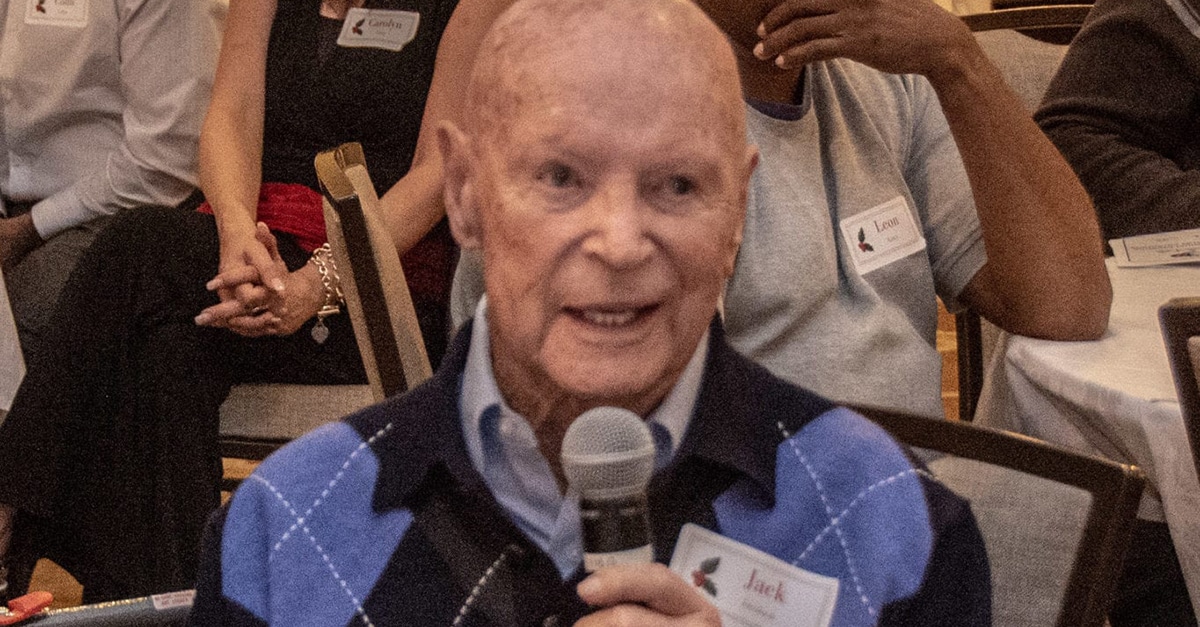Dr. Jack Jacobson has lived his life serving, rallying, and winning, both in the medical field and on the tennis court. CATA is fortunate to have this outstanding leader living in our service area and, recently, CATA staffers had the opportunity to visit with Jack and his wife, Elizabeth, in their lovely home high above Courtyard Tennis Club to learn more about Jack’s influence on and off the court.
Jack, born in 1931, was always a natural athlete, excelling in football, and tennis. He was recruited by the University of New Mexico on a football scholarship but was injured. He then transferred to Amarillo Junior College where he played scholarship tennis and basketball. As a finalist in doubles for the JC state championships, Jack was recruited by Texas A&M and transferred to play for the Aggies, graduating with a degree in floriculture in 1953.
Having followed in his father’s footsteps, Jack became interested in medicine at a young age by observing his father’s surgeries. At age twelve, Jack performed ‘elective’ surgery on his mother’s cat, learning that 1) cats do not have an appendix; and 2) his mother did not appreciate his choice of patients. Jack persisted in his curiosity, however, and became a medical student at UT Medical Branch in Galveston. Athletic and resourceful, Jack found creative ways to combine his love of medicine and tennis.
Medicine took Jack from Texas to Washington State, where his residency included public health and general surgery, but very little tennis. Tired of the cold, wet weather of Seattle, Jack accepted a stint for his compulsory military service in Tahlequah, Oklahoma, providing health services for the Cherokee Indian tribes in the area. After finishing a urology residency in 1963 at the University of Kansas, Jack and a fellow urology resident, John Bull, decided to relocate to California where the weather was better, to begin private practice of urology. As a tennis player from an early age, Jack was glad to be in a climate where he could play year-round.
By 1967, Jack was playing tournaments around the country and working in his private urology practice in Ventura County, California. Sitting around with other physician players after a tennis event in Palm Springs, Jack and his friends came up with the idea of forming a tennis association for doctors. Fueled by beer and encouragement from Bill Drake, editor of RX Golf & Travel, who promised that he would advertise if they formed the association, Jack and his friends founded the American Medical Tennis Association. Their mission was to combine tennis with quality continuing medical education. The idea took off with their international peers soon after and the World Medical Tennis Association, strong today—more than 50 years after its inception—keeps doctors healthy by offering tennis events along with medical meetings all over the world. Jack has won international tennis events in Munich, Helsinki, London, San Diego, Fort Worth, and Malta.
Not pleased with the high school courts he played on in California, Jack decided to build his own tennis club. The Cabrillo Racquet Club opened its doors around 1975 and soon expanded to 17 courts. Wayne Bryan (who recently had decided practicing law did not suit him as much as tennis) applied for a job at Cabrillo to direct the tennis program. Wayne, along with wife Kathy Blake Bryan, built the club’s reputation as a premiere junior training facility, likely helped by the birth of twins Bob and Mike who became top Stanford players and later turned pro. In 1980 Jack was offered a position to teach at Texas A & M Medical School, so he sold the club to Wayne Bryan and left California to come back to Texas, where he taught urology and was Chief of Urology at the Veteran’s Hospital in Temple, Texas. Missing his days in private practice, and upon advice about the incredible growth in Williamson County, Jack opened a private practice in Georgetown with one of his former resident Dr. Elizabeth Rutledge. The practice did very well, expanding to Round Rock and north Austin, and he worked full time until retirement in 2008 at age 77.
Despite a very busy medical practice and raising a family, Jack prioritized tennis. Between 1982 and 2014, Jack was ranked multiple times in the top 5 in Texas in both singles and doubles and also held top 10 national rankings. He continued to play five times a week until age 83, when he developed significant health problems and also had major back surgery. A stroke in January this year affected his balance, but despite being age 88, he has been working to recover and to be on the court again some day.
These days he is more likely to be on the sidelines offering commentary and pointers, but Jack’s influence on the game has been recognized by many. He was given the inaugural Craig Broome Award in 2012 by the AMTA, an award which recognizes contributions to tennis, medicine, and AMTA. He was awarded the CATA Inspiration Award in 2018, nominated by Dr. Gene Waters……
Jack has found a way to live life on his own terms, playing tennis his entire life while also
serving others through medicine and leadership. As a role model and doctor, Jack leaves us with
these tidbits:
- Find something you love that you can do all your life;
- Increase your tennis shoe size a half size for every 10 years after age 50;
- Remember the famous quote from his brother in law Texas A & M tennis coach David Kent: “the older you get, the better you played!”
Jack was a great player, inspirational role model, and he continues to write a great legacy.

